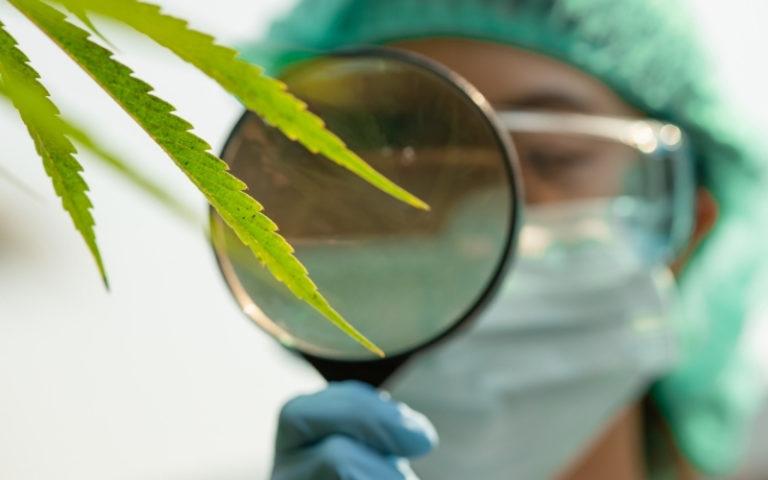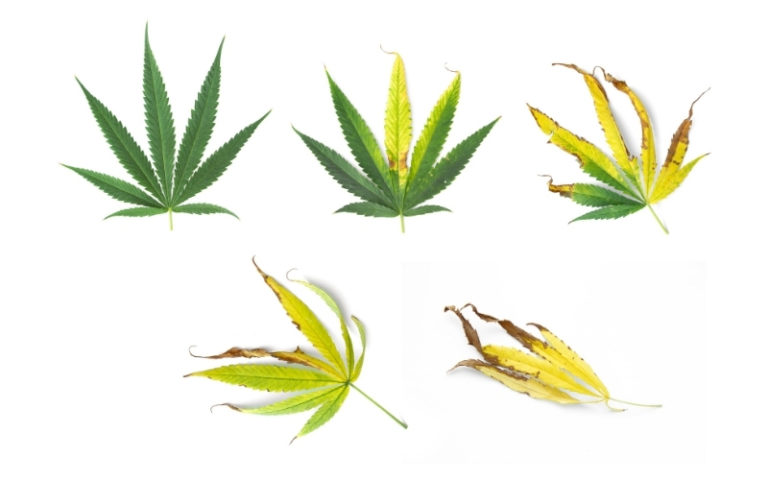
Diving into the world of growing cannabis? Here’s everything a new grower should know about cannabis nutrient burn, nutrient deficiencies, and nutrient lockout.
What is cannabis nutrient burn and what causes it?
Nutrient burn is damage caused by over-fertilization. Plants can’t control how many nutrients they absorb, so if the growing medium contains too many nutrients, the plant will get sick. An overabundance of nutrients can cause a plant to display signs of nutrient burn, which looks a lot like an actual burn. Cannabis plants will yellow and brown, giving them an appearance of burnt tips. They’ll also undergo color changes and stunted growth.
Nutrient burn can be devastating. While it can’t be reversed, it can be corrected and should be as soon as possible. Nutrient burn can cause root damage as well as damage to the leaves, which won’t be able to absorb light or contribute to photosynthesis.
 Early signs of cannabis nutrient burn
Early signs of cannabis nutrient burn
If your plants are showing signs of early-stage nutrient burn, be on the lookout for these signs. Keep in mind that many symptoms of nutrient burns are practically the same as nutrient deficiencies, so test your pH levels regularly.
- Deep, dark green water leaves
- Yellow or brown tips of the leaves (burnt tips)
- Stunted growth
- Yellowing, drooping leaves
- Leaf tips are bending
Signs of late-stage nutrient burn in cannabis plants
When caught early, nutrient burn is pretty easy to correct. However, you’ll run into symptoms of advanced nutrient burn in older veg plants and in flowering stage plants if you don’t adequately resolve the issue. Signs of late stage nutrient burn are:
- Yellow or brown along the edges of the leaves
- A “halo” that shows a clear separation between healthy tissue in the center of the leaf and yellowing on the edges
- Leaves start yellowing and curling downwards
- Leaves start twisting and curling in all directions
The difference between nutrient burn and nutrient deficiency
The key difference between nutrient burn and nutrient deficiency is the amount of nutrients the plant is exposed to. An overabundance of nutrients causes nutrient burn, while a lack of nutrients causes nutrient deficiencies. In nutrient deficiencies, cannabis plants will show similar signs of nutrient burn, but will draw nutrients from the healthy leaf tissues that it can’t find in the soil.
For example, cannabis plants use lots of nitrogen during the vegetative stage of growth. Some strains will suck so much nitrogen out of the soil that it can no longer support itself as it grows larger. However, flowering plants focus less on nitrogen and more on phosphorus and potassium. If you use the same soil every growing season, your next few runs may deplete these nutrients and cause a nutrient deficiency.
That’s where the trouble comes in. Nutrient burn and nutrient deficiencies look so much alike that novice growers can sometimes have a hard time determining what is causing the problem. By amending the soil or hydroponic growing medium, some growers may accidentally overfeed the plants and cause them to display signs of nutrient burn. Nutrient burns are often caused by growers when plants are displaying symptoms of nutrient deficiencies.
How to tell nutrient burns and nutrient deficiencies apart
The first symptom of both is the yellowing of leaves. Look at it as an indicator of distress before you dive into your growing medium, water, and environment. The first sign of both nutrient burns and nutrient deficiencies is drooping, yellow leaves, which can also simply be a sign of overwatering.
If you know your soil is well-prepared at an adequate pH and you’ve ruled out bugs and overwatering, you likely have a nutrient deficiency. The patterns on the leaves can give you a good idea of which specific nutrient is missing.
On the other hand, if you were overfeeding your plants to correct a nutrient deficiency, you’re probably experiencing nutrient burns. Nutrient burns are caused when certain nutrients create deficiencies of other nutrients in plants, causing fertilizer toxicity which can poison your plants. The most common fertilizer toxicity in plants is nitrogen toxicity, which can cause nutrient lockout.
 What is nutrient lockout and how do you fix it?
What is nutrient lockout and how do you fix it?
Nutrient lockout is caused by excess nutrients and unsuitable pH levels in the soil, water, or nutrient solutions. It occurs when the levels of some nutrients are so high that the plant can’t take any other nutrients from the soil. Nutrient lockout causes plants to wither and die.
Lockout looks a lot like a nutrient deficiency. They are deficient, as they’re technically starving, but they’ve been given too many excess nutrients. This causes them to be unable to absorb the nutrients they need to survive.
Diagnose it by testing the pH of your water with a TDS meter. It should be between 6.0-7.0. Too high or low drastically drops nutrient availability and makes it impossible to absorb nutrients. You should also make sure your soil is between 5.8-6.8 or your hydro solution is between 5.5-6.5.
If your pH is off, you may have nutrient lock. Stop giving your plants nutrients, and flush your plants with nothing but water to break down salt build ups and clear pathways for nutrient absorption. After flushing, let your growing medium dry out before watering again to avoid root rot. Only water with clean water for a few more cycles before introducing nutrients again. Your plants may look really sad for a while, but they’ll bounce back.
How do you fix a nutrient deficiency?
Fixing a nutrient deficiency is much easier than fixing nutrient burn or nutrient lockout. To diagnose a nutrient deficiency, first check your soil, hydro solution, and water pH levels to rule out any problems. If your pH is fine, you may be missing one or more nutrients. Look at your leaves to diagnose signs and symptoms of specific nutrient deficiencies. Here’s a good visual guide.
From there, you’ll just amend your growing medium with the required nutrients. Just remember to start low and go slow. Adding too much of a nutrient all at once can cause lockout or nutrient burn.
How do you fix nutrient burn?
Fixing nutrient burn involves a few different steps. Since you’re experiencing an overabundance of nutrients in your plants, you’ll first need to cut your losses and remove the afflicted leaves, flowers and stems from your plant. Nutrient burn can’t be reversed, but removing this tissue prevents the plant from poisoning itself when it draws nutrients from its leaves.
Next, you’ll flush your growing medium to remove excess nutrients. In a hydro setup, you’ll empty your reservoirs and refill them with nutrient-free pH-balanced water and flush the growing medium for 24 hours. In soil, you’ll need to heavily water your plants with pH-balanced water, allowing excess water to run off through the pots and repeat until the runoff measures a healthy result by a TDS (total dissolved solids) meter.
From there, you need to figure out what caused the over-fertilization in the first place. When using soil, you should make sure you aren’t using things like fresh manure or artificially nutrient-enriched soils. In hydro grows, ease back on the nutrients you add to the solution. Use an EC meter to make sure your levels fall in line with what the plants needed before they were burned.
Keep in mind that all strains are different. Some strains require more intense lighting and others require different amounts of different nutrients. Some individual plants will need more attention. Be sure to constantly monitor and adjust accordingly to any and all visual cues your plants give you.


 Early signs of cannabis nutrient burn
Early signs of cannabis nutrient burn What is nutrient lockout and how do you fix it?
What is nutrient lockout and how do you fix it?